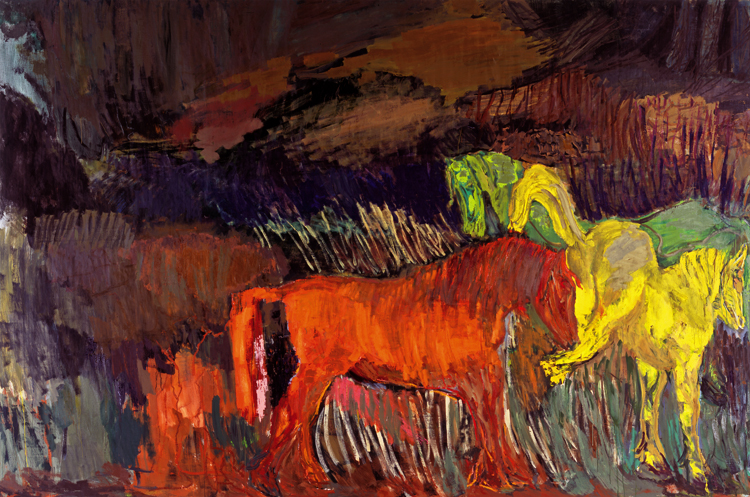The largest of Per Kirkeby’s paintings in our current exhibition—Untitled (2009)–is a favorite of many visitors. In an interview with Director Dorothy Kosinski, Kirkeby said:
I took the horses not from any kind of photos but from the famous works by Baldung Grien, who has four or five very fantastic woodcuts. So that’s a kind of borrowed structure. Woodcuts are very clearly defined with lines. So from them I got a starting point. One of my sons gave me a birthday gift of a big beautiful book full of pictures of horses. I dare not say it, but what am I going to do with that? I don’t need a real horse. I need the lines that pretend to be a horse.
Hans Baldung Grien was a German Renaissance painter and a prolific printmaker. He was a student of Albrecht Dürer. Grien produced three woodcuts of wild horses, each print not much bigger than a sheet of letter-size paper. Kirkeby probably chose his three horses from a herd in Grien’s Stallion and Kicking Mare with Wild Horses (1534).

Hans Baldung Grien (Germany, Schwäbischgmünd (?), 1484 – 1545), Stallion and Kicking Mare with Wild Horses, 1534. Print, Woodcut, Sheet: 9 x 13 1/8 in. Los Angeles County Museum of Art
What about the colors he chose for the three horses–red, yellow, and green? The light yellow and spring green shows up in many of Kirkeby’s paintings throughout the years, almost like a signature; perhaps they are the hopeful colors of spring after a long Danish winter. Maybe they suggest the colors of autumn, as Kirkeby has written in his book Isolation of Parts: “Yellow – red and green are the most crucial of colors. Green is the surface until the plants yield to desert yellow and red.” Chlorophyll yields to xanthophyll and anthocyanin. Or perhaps he has a distant memory of a 100-year-old painting by Franz Marc of three cows, in which a yellow one kicks up its heels with a red and a green companion.

Franz Marc, Cows, Yellow-Red-Green, 1912. Oil on canvas, 24.4 x 34.4 in. Staedtische Galerie im Lenbachhaus, Germany.
Kirkeby’s medium for this horse painting is unusual: tempera on canvas. Although he is rather coy about his technique, he has written:
Move from oils and that hazardous turpentine to water-soluble paints, break down what is wooly and impasto. A more fluid, drier character emerges. From the same material in terms of content. . . . I am now intending to switch to water-soluble paints and protect my brain from turpentine-induced decay. That is my choice, and it is perhaps one that in the same way as other choices of such ‘technical’ nature will lead to something new. A new and unexpected turn.
In this case, his use of tempera led to horses.
Ianthe Gergel, Museum Assistant


These posts about Per Kirkeby have been welcome for the insights that the reference sources provide. I appreciated the opportunity to see the work at the Phillips.
I’m glad you’ve enjoyed them, Maureen. There’s a lot to learn about this artist who is less well known in this country. I really recommend watching the film about Kirkeby that is part of the exhibition. Many have found it illuminating.
That’s a wonderful painting and the affinities with/influences of the medieval German master and the (sadly early lost) Modernist are fascinating. I have to get to this show!